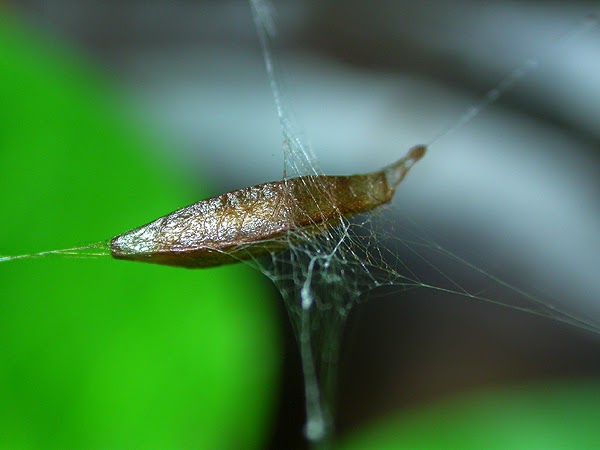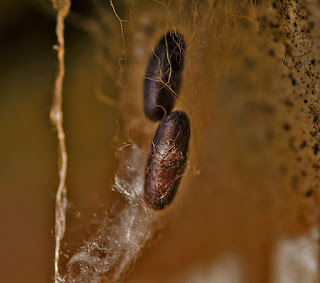In November 2013, I found this Gibbaranea gibbosa in Hassocks,
West Sussex. I sent the recording to Peter Harvey of the British
The spider is a juvenile male, in mid-molt.
Paynes Southdown Bee Farm, Hassocks, West Sussex
17.10.13
I collected the spider, with the aim of raising it to adulthood.
It was only when I got it home, that I noticed it had a parasite attached just
behind the carapace.
I observed it's growth over the next few weeks, and eventually it pupated,
hanging from the strands of silk left by the spider.
I observed it's growth over the next few weeks, and eventually it pupated,
hanging from the strands of silk left by the spider.
Brighton, East Sussex
02.11.13
Peter Harvey suggested that I send the images to Dr. Mark Shaw - the leading
UK authority on Spider parasitoids. I did so, and this was Mark's reply :
"I have never found Gibbaranea gibbosa, parasitised or not, but your
parasitoid is (to judge from its position on the host) most likely to be
a
Polysphincta sp., the species of which parasitise the larger
Araneidae (there
are several possibilities, but only one is really
common). A different genus,
Sinarachna, also uses this host group, but
it is always positioned half way
along the abdomen, not right at its
base as in Polysphincta. However, all
species of both genera normally
overwinter as small diapausing larvae on the
host, only doing the rapid
development you saw in the following spring (there
is also a
fast-developing summer generation of most species, but that would
be
over by August at the latest). Therefore, for all of the foregoing
reasons, I
would be really interested to see the adult parasitoid once
it emerges - or to
have the cocoon (if it has spun it yet - just leave
the larva undisturbed in the
spiders silk and it should manage to do
that...in your pic you can particularly
clearly see the specialised
wart-like structures that help it to move around in
and hold onto
spider's silk). There should be the remains (shrivelled up, just
its
skin) of the spider somewhere on the floor of the container I think -
please
also keep these".
Unfortunately, the coccoon fell from the spider silk, and deteriorated in the
substrate at the bottom of the jar. I spent hours, sifting through the soil with
tweezers, but sadly, to no avail. This was my first attempt at raising a
parasitoid, but a real shame that I failed as it seems it was likely to have been
a new/ unknown species :
"I consulted a colleague (Niclas Fritzén, in Finland) and he says he has no
records of a Polysphincta ex this host (the position of the larva
suggests
Polysphincta), so it might be worth trying to get a det for it
by DNA".
Dr. Mark Shaw
I was so fascinated by this parasitoid, and the information that Mark shared,
that I was determined to succeed in rearing any parasitoids that I found.
I purchased Mark's book - Rearing Parasitic Hymenoptera from the Amateur
Entomologist's Society. It is a truly fascinating read and I found that I was
hooked on the idea of rearing these parasitoids.
In March of 2014, I found this Tetragnatha sp., on a life buoy at Railway
Land Nature Reserve in Lewes, East Sussex.
Railway land Nature Reserve, Lewes, East Sussex
15.03.14
15.03.14
I collected this spider and sent these images to Dr. Mark Shaw :
"It will be one of two Acrodactyla species. Both are quite widespread and
fairly common ex Tetragnatha spp."
Two weeks later, the larva had pupated, attached to the silk left by the now
deceased spider.
Brighton, East Sussex
20.03.14
Roughly two weeks later, the parasitoid hatched from it's coccoon.
Brighton, East Sussex
02.04.14
02.04.14
The hatched Acrodactyla sp. (Tetragnatha spp. parasitoid)
"Male Acrodactyla carinator (Aubert 1965)" - Id by Dr. Mark Shaw
"Male Acrodactyla carinator (Aubert 1965)" - Id by Dr. Mark Shaw
The Wasp is now stored at the Scottish Natural History Museum.
The day after finding the Tetragnatha spp. in Lewes, I found a Baby
Araniella sp., also with an attached parasitoid, in Isfield, East Sussex
The spider was about 1,5mm in size, and difficult to photograph, but I sentthese images to Dr. Mark Shaw :
"On Araniella in that position it might be Sinarachna pallipes. Otherwise, if
in a transverse position like your thing from G. gibbosa, there are 2
Polysphincta species that are possible : P. boops (rare), and P. tuberosa
(common).
My next find, was this Agalenatea redii playing host to a parasite.
I was sat by a stream at Ditchling Common, East Sussex, when this spider
appeared on my leg. I collected it and took it home, to rear.

Ditchling Common, East Sussex
18.04.14
Again, I sent this image to Dr. Mark Shaw :
"That could be really interesting - the position suggests it is not a
Polysphincta (which is the genus that usually goes for the larger araneids)".
The larva pupated 23.04.14, but unfortunately, the adult did not emerge.
I sent the remains to Dr. Mark Shaw - "The remnants of your A. redii
parasitoid (from Ditchling Common) had got to pharate adult stage, and is
probably in good enough condition to get a det via DNA...I will send it to
Niclas Fritzen".
Currently awaiting a DNA reading.
My next find, was this young spider, from the Theridiidae family.
I sent the images to Peter harvey of the B.A.S. / S.R.S., who kindly
identified it as probably Achaearanea sp. It was on a
gravestone that I visit at the Extra Mural Cemetery in Brighton.



Theridiidae (possibly Achaearanea juvenile) with parasite
Extra Mural Cemetery, Brighton, East Sussex
14.06.14

Two days after collecting this parasite and host, the larva pupated.
Brighton
16.06.14

Brighton
23.06.14
One week later, the Theridiidae parasite hatched.
I sent it to Dr Mark Shaw to identify :
"It is a male Zatypota albicoxa, which is indeed a parasitoid of Achaearanea
spp, and rather uncommon in Britain".
Two months later, 22.08.14, whilst looking at the same gravestone where I
found the Achaearanea spp. with parasite, I found a pupa (no spider
present). I collected it to see if I could raise it to hatch.
It hatched one week later. I think it may be a female Zatypota albicoxa.

Brighton
29.08.14

Possibly a female Zatypota albicoxa, with cocoon.
I sent this to Dr. Mark Shaw :
"Indeed it is a female Zatypota albicoxa. Thanks very much - I am pleased to
have another nice specimen of it, and it is nice to know that a single
gravestone can be so productive!"
I photographed this Achaearanea sp., with parasitoid larva, in an old
woodland. I did not collect the spider, as I did not notice the attached larva
until I enlarged the photograph, later that day.

Hassocks, West Sussex
24.09.14
From the same woodland, and on the same day, I collected this Metellina sp.,
with attached parasitoid larva.



Brighton
29.09.14
The larva got so big and heavy, that it pulled the spider from it's web.
Luckily, it landed on the cotton wool that I had placed inside the container,
so to safely transport the spider.
The "paler than usual non-overwintering coccoon" - Dr. Mark Shaw
Brighton
12.10.14
species of the "polysphinctine" spider-parasitoids group that overwinters as a
cocoon - all the others do it as a very small larva on the overwintering host
spider (at least, as far as is known...one or two species have yet to be reared).
So it will not hatch until next year - it will need to be kept in a cool and damp
place (ie not too dry...in an outbuilding that doesnt get sunshine, or a garage),
but you could bring it indoors again in about March and it should hatch OK.
Although it is not a really rare species, it would be vey nice to have the
specimen in due course because specimens from known hosts are always
valuable (although I appreciate the host det in this case may only be to genus).
I did this, and to my surprise, the adult hatched a week later.
Brighton
20.10.14
I sent the adult wasp, the coccoon and the remains of the spider to
Dr. Mark Shaw. He identified it as a female Megaetaira madida.
"I guess that, as it is anyway plurivoltine, that Megaetaira madida of yours
just squeezed in an extra generation and hatched without overwintering. But
the species does overwinter in a cocoon (I presume rather than on a host, ever
- but I suppose it may be able to do both, though I would be a bit surprised)".
I'd like to thank Dr. Mark Shaw for all the fascinating information that he
has shared on this subject. I will continue to search for spider parasitoids
and attempt to rear them to adulthood.
Paynes Bee Farm
Hassocks, West Sussex
10.07.15
Hassocks, West Sussex
10.07.15
"The
spider is Theridion varians (or possibly T. hemerobium, which can be
very similar). The parasitoid on T. varians is usually Zatypota
percontatoria, but sometimes when the larva is anteriorly (like on this
specimen) I have also got Z. bohemani from this species". Niclas Fritzen
Update :
"The spider parasitoid is male Zatypota percontatoria...quite common ex Theridion varians".
Dr Mark Shaw
"The spider parasitoid is male Zatypota percontatoria...quite common ex Theridion varians".
Dr Mark Shaw
The beginnings of a cocoon
18.07.15
For the record.
Zatypota percontatoria
28.07.15
Metellina sp., with Parasitoid larva attached.
Found at Paynes Bee Farm 08.10.15
"The parasitoid on Metellina is presumably Megaetaira madida (used to be in genus Acrodactyla) which is one of the very few polysphinctines that overwinter in their cocoon". - Dr Mark Shaw
Linyphidae (possibly young Labulla thoracica) with parasitoid larva attached
Brighton
27.11.16
"It will be in the Acrodactyla degerer complex…either Acrodactyla degener or A. similis (but there might be yet more spp)". - Dr Mark Shaw
I am presently rearing this parasitoid.
The larva has pupated - roughly two weeks from now, an adult Wasp will emerge.
24.12.16
Clubiona sp. with parasitoid larva
"Two fairly common British species of the genus Schizopyga parasitises Clubiona species, and another (very rare) Schizopyga uses Cheiracanthium [there is a 4th in Britain, with unknown host, and at least two more in Europe, also with unknown hosts]. The egg placement of Schizopyga is at the back of the cephalothorax, as in your pic" - Dr Mark Shaw
Brighton
07.12.16
I am presently rearing this parasitoid.
The Clubionid Parasitoid has emerged.
It is Schizopyga circulator (confirmed by Dr Mark Shaw)
Brighton
27.12.16
It is Schizopyga circulator (confirmed by Dr Mark Shaw)
Brighton
27.12.16
Schizopyga sp larva on Clubiona sp
Brighton
24.02.17
The hatched Clubionid parsitoid - 'Schizopyga frigida,
as the mid tibia is all-red' - Dr Mark Shaw
12.03.17
12.03.17
I found these pupae in an old spider egg sac -
collected for rearing
'...probably Hemiteles similis, which is a common
parasitoid of Zygiella sacs. Often found around
doors/windows outside houses' - Dr Mark Shaw
Extra Mural Cemetery, Brighton
13.03.17



































No comments:
Post a Comment
Note: only a member of this blog may post a comment.